We didn’t spend all our time in London socializing and taking in the sights. We also completed a number of projects, for the boat, the web site, ourselves and even Spitfire.
Below are highlights from Feb 13th through April 12th in London, UK. Click any image for a larger view, or click the position to view the location on a map. And a live map of our current route and most recent log entries always is available at mvdirona.com/maps
 |
Spare Spitfire
Position: 0 4.30, 51 30.40
We found another spare Spitfire underneath the pilot house settee when inventoring some parts.
|
 |
Inflatable Fender
Position: 0 4.30, 51 30.40
After two of our ProStock inflatable fenders failed in Dublin, we’ve been considering replacement options. Spending $250 on a fender that only lasts three years doesn’t feel like good value, and we have at least one more that is showing the same material flaw, so we decided to try another brand that is half the price. The EasyStore 42x132cm inflatable fender we ordered from Marinescene two days ago arrived today.
|
 |
Fender in Place
Position: 0 4.30, 51 30.40
The EastStore fender doesn’t seem quite as durable as the ProStock fender behind it, but looks reasonable. And at nearly half the price, it only has to last two years to be better value.
|
 |
Racor CCV
Position: 0 4.30, 51 30.40
We’ve never been happy with the RACOR CCV (Closed Crankcase Ventilation) system on our Deere engine so decided to dig in and learn more. Read more …
|
 |
O-Ring
Position: 0 4.28, 51 30.40
James noticed our oil filter was wet with oil today. A quick check showed the filter housing was leaking at an O-Ring Boss fitting. He removed it and found the O-ring was as hard as a rock and split as it was removed. He replaced the O-Ring and, in under 5 minutes, it’s back running without a leak. It’s nice having the right spares.
|
 |
Latch
Position: 0 4.28, 51 30.40
The latch on our upper pantry failed this morning, so we’re replacing it with a spare.
|
 |
Parts Box
Position: 0 4.28, 51 30.40
One of our boxes of bolts and screws took a tumble during the yard visit and broke. The replacement box we bought on amazon.co.uk arrived today, so we’re transferring the pieces.
|
 |
Throttle
Position: 0 4.28, 51 30.39
Back in January we installed autostart on the main engine (Two Generators When You Only Have One). This gives us another layer of defense to protect our batteries. If our generator ever fails (it hasn’t), the main engine will be automatically started by the control systems and it acts as a 9kw generator backing up our Northern Lights M843NW3.3 12kw generator.
This install went well, but the Dynagen TG410 throttle signal was not recognized by our Deere 6068AFM75 main engine. It’s not really a challenge to change this but you do need a Deere technician with Service Advisor to make the change. We had that small engine control unit configuration change made and it worked great. The engine is now fully under control system authority if the generator fails. But, as with all jobs, there is always at least one surprise or additional complexity. In this case, the Deere signals alarm when the analog throttle control signal is not available. The TG410 throttle signal, if present, dominates so the TG410 has full control when the main is operating as a generator but, of course, it still needs to be a main engine so needs an analog throttle control signal for the normal case. When operating as a generator, the helm control is not active and so the analog control signal is not available and the Deere alarms. Everything works perfectly in main engine mode and in generator mode but the alarm in generator mode is annoying even if it will rarely happen. Here James is figuring out the ZF ClearCommand 9000 so the control system can turn it on, “take control” at the PH helm, and avoid the extraneous “missing analog throttle signal” alarm. We’ve tested simulated generator failure. If it’s not charging, the control system shuts it down properly, raises RPM, warms up the engine, and applies the load. When the batteries are charged, it’s shut back down. |
 |
High Idle
Position: 0 4.28, 51 30.40
Our Deere 6068AFM75 comes with a factory idle setting of 600 RPM. On Dirona we want more power available to the hydraulics at idle so we use 800 RPM as low idle. At that speed, it still shifts smoothly, runs smoother, and when used with the wing gives full hydraulic output. When the engine is cold, we raise the idle to 900 RPM during warmup for smoother operation. Peter Hayden (http://www.mvtanglewood.com/) pointed out the ZF Clear Command 9000 has a fast idle setting. By setting E6 to 18 (any number between 0 and 20), with one touch at the helm control we can move the idle up to 900 RPM. Again with one touch at the helm control it’ll revert back down to the normal idle of 800 RPM.
|
 |
Polyform Fenders
Position: 0 4.28, 51 30.40
Our two new Polyform fenders from Boat Fenders Direct arrived today, part of our third approach to a fendering strategy. Read more …
|
 |
Ham Radio
Position: 0 4.28, 51 30.40
A few months back, when entering the lock in Liverpool, we were asked to Monitor channel 37A also called M1 in the UK. We have 6 VHF radios on board from leading suppliers such as ICOM anbd Standard Horizon. Each radio has three modes to support US, Canada, and International but none of these options support either M1 or 37A. We managed OK without having the ability to listen to the lock attendant on that channel but it would be been nice to have it available. This is the first time we have ever encountered a VHF channel used anywhere in the world that we can’t listen to. It turns out that this channel is unique to the UK market and radios sold into this market have it added but radios sold into most other markets don’t have the support. Annoying, but the solution was easy: buy another VHF radio. Still with so many VHF radios on board, it seems crazy to have to buy another.
Blog reader Andrew Dickenson had a great suggestion: purchase a ham radio that can be programmed to any VHF channel available in the world. The FCC restricts transmissions on Ham radios but unlicensed operators can use them to receive. Going with the Ham radio has the advantage of solving the problem here in the UK but it’ll also solve it everywhere else in the world if we end up finding other channels we can’t pick up. Even better, it’s much cheaper than a VHF radio. For $34.99 we picked up a Baofeng UV-5R+ from Amazon. James spent a bit of time learning to program the radio but it can now pick up every marine VHF he could find in reasonably extensive searching for marine frequencies used anywhere in the world. |
 |
Baofeng UV-5R+
Position: 0 4.28, 51 30.40
After programming our new Ham radio to be able to be able receive all world-wide marine channels, we configured it to use text based channel names rather than the default frequency. This makes it an easy and quick-to-use option for monitoring VHF radios. Here we are monitoring channel 16 and the UK M1 channel. The radio can switch between two channels with a single button press or monitor both for activity. Since the entire list of world-wide marine VHF channels doesn’t completely fill the 127 channel storage locations, it can also monitor unlicensed communication channel in what ever jurisdiction we happen to be operating (e.g. FRS, MURS, LPD433, GMRS, Freenet, KDR44, PMR446, or SimpleUK). Overall, the Baofeng UV-5R+ is a pretty impressive little package for only $35.00.
|
 |
London City Dentists
Position: 0 4.65, 51 30.71
At London City Dentists for a regular checkup and teeth cleaning—Dr. Holness there does excellent work. We handle some medical appointments when we’re back in the US, but prefer not to defer everything until then. London has great services available.
|
 |
Specsavers
Position: 0 4.84, 51 31.02
At Specsavers to order some new glasses. Jennifer’s current pair came from Specsavers in Brisbane, Australia when we were there in 2014.
|
 |
Hirschfelds
Position: 0 6.50, 51 31.16
At Hirschfelds on Hatton Garden to repair some jewelry. They did an excellent job at a very reasonable price.
|
 |
Westfield Stratford City
Position: 0 0.18, 51 32.55
We’d built up a big shopping list in the months before arriving in London and made two trips to Westfield Statford City, also visiting Olympic park while we were there. Read more …
|
 |
High Water Alarm
Position: 0 4.26, 51 30.40
Our bilge high water alarm was triggering spuriously. We found that the Maretron sensor will trigger if any high density object comes within 1/4-inch of the detector side. So James mounted it on the Rule 3700 bilge pump hose so it is at the right level and nothing will enter the trigger zone (other than bilge water).
|
 |
Condensation
Position: 0 4.26, 51 30.40
We traced the source of a freshwater leak into the bilge to condensation on the HVAC strainer due to the low 40°F saltwater temperature in the marina. Warmer engine room air condenses out when it hits the strainer and cools. We wrapped an insulating rag around each pipe.
|
 |
London Cat Clinic
Position: 0 4.37, 51 29.74
Dr. Jeremy Campbell of London Cat Clinic giving Spitfire a health exam prior to a 3-year rabies vaccination. Spitfire’s last rabies vaccination was done in Darwin, Australia.
|
 |
Water Maker Remote
Position: 0 4.26, 51 30.40
The water maker has been spuriously turning itself on without warning, so we have started to keeping it powered down. We still flush the system weekly but today when we powered it up for the weekly flush, the remote panel didn’t work. We tried flushing directly from the water maker and it worked well, so we knew we had a remote panel problem. What we found was the CANbus wire that runs between the water maker and the remote panel has gotten stiff over the years and there is now quite a bit of force pushing the connection laterally. Once that is relaxed and the connector fully inserted, everything is back to working correctly without spontaneous operation. James is pointing to the connector in the picture.
|
 |
Actuator Change
Position: 0 4.26, 51 30.40
ABT recommends that the stabilizer actuators are changed every 2,000 hours. Since even a failed actuator doesn’t negatively impact the operation of the other side, I usually change them only once they start showing any sign of age. Their lifetimes seem to range from 2,500 hours to well over 6,000 hours. This one was last changed on our run from St. Helena to Barbados back in 2016 and has been in service for 3,209 hours. It has just begun to leak and so it’s time to make the change. Here James has the cover off the fin position sensor but the sensor is still in place. Once the sensor is off, the top plate is removed revealing the actuator. It’s a fairly easy two-hour procedure to change if all goes well.
|
 |
Tight Quarters
Position: 0 4.26, 51 30.40
On Dirona, the port side fin is behind the primary fuel filter and under the fuel tank extension, making it more difficult to access than the other fin. However, the fuel tank extension gives the N52 200 more gallons of fuel on each side over the N47 which I love so I shouldn’t complain about the slightly tighter service access. At the dock, changing even the port side fin is a fairly easy job. The last time I did it was in equatorial conditions, in a hot engine room, with the engine roaring behind me so this one was quick and easy.
|
 |
Old Actuator
Position: 0 4.26, 51 30.40
This is the old fin actuator that was just removed. Note how small the hydraulic ram is. Most of the lift of a hydraulic fin is delivered directly into the fin shaft and bearings so it takes very little force to move the fins. Our hydraulic system normally operates at 3,800 PSI but only needs 1,500 PSI to drive the fins even with this very small hydraulic ram. They just don’t take much force which is good because fin force is overhead that eventually costs fuel economy and range. It’s nice to not to have to give up material range in order to enjoy a stabilized boat.
|
 |
Cat Litter
Position: 0 4.26, 51 30.40
This is why we use Tidy Cats Breeze and not regular cat litter—it makes a real mess and tracks everywhere. Spitfire had developed diarrhea from the antibiotics he had to take after his surgery, so we’d switched litters temporarily to conserve our supply of Tidy Cats Breeze pellets. Twice a day it looks like this—we’ll be back to the normal system the very moment we can.
|
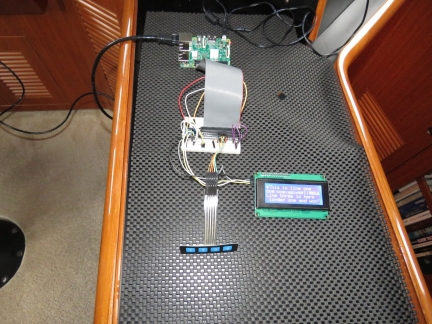 |
4×20 LCD Output
Position: 0 4.26, 51 30.40
James has interfaced a 4-line 20-character LCD to be driven by a Raspberry Pi. The display is interfaced to the Pi using the I2c (Inter-Integrated Circuit) protocol. If the output lines are longer than 20 characters, the system repeatedly scrolls the longer lines. The output can be changed at any time and the screen can be turned off using the 1×4 matrix keyboard. If new text is sent to the Pi, then it’ll display those lines instead. With the 4-key keyboard, the system can display different outputs at user request. For example, we could have one key request the display of all boat temperature sensor readings and another key could request the fuel tank levels be shown. At this point, we don’t have a direct application for the display but suspect a small display will come in handy somewhere on Dirona.
|
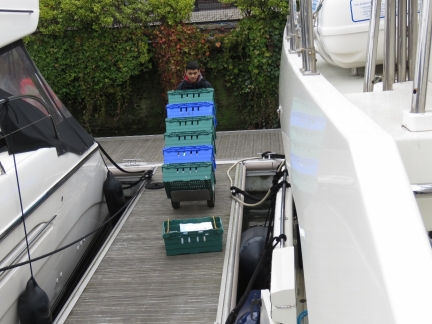 |
Tesco
Position: 0 4.26, 51 30.40
Tesco delivering a load of groceries—one of several orders we’ll place as we stock up for our Norway trip.
|
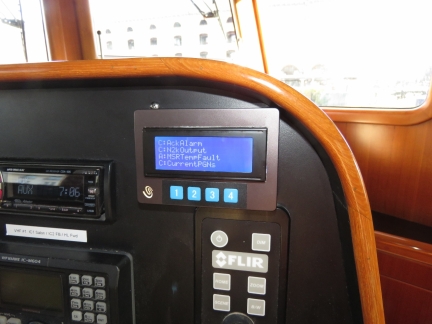 |
4×20 LCD Output
Position: 0 4.26, 51 30.40
Earlier this week James interfaced a 4-line 20-character LCD and 1×4 matrix keyboard to be driven by a Raspberry Pi. Yesterday he installed the LCD and keyboard into the case from a USB disk drive and mounted the unit on the pilot house dash where it is readable throughout the pilot house. We’re using it display the four most recent alarms and warnings from our automation systems. We use Maretron N2kView to display most boat system status alarms, indicators and warnings, but there is no provision to display arbitrary text messages.
|
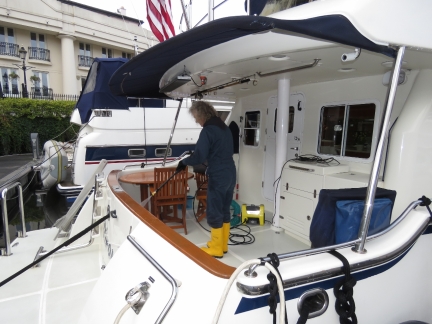 |
Boat Wash
Position: 0 4.26, 51 30.40
We’re absolutely loving St. Katharine Docks and have already extended our stay twice. The only downside is the boat gets dirty rather quickly, as we are in downtown London. But more regular boat washes is a small price to pay for such a fabulous loctation.
|
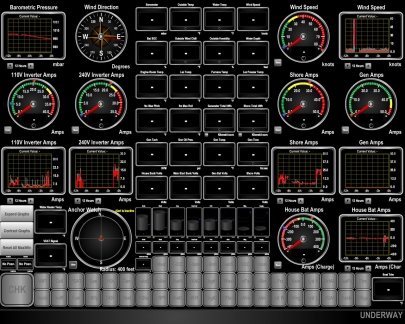 |
NMEA 2000 Down
Position: 0 4.26, 51 30.40
We woke up late last night to the sound of the main engine starting. Earlier in the day we’d inadvertently turned off the breaker to our 12V navigation system battery, which had discharged, bringing down the NMEA 2000 bus that relies on 12V power. This effectively blinds our control systems on the information it needs to make decisions. When the control system can’t determine the battery voltage levels, it starts the generator, since we would rather run the generator too much than discharge the house batteries. The generator was unable to start due to the NMEA2000 system being down, so the control system went to the emergency backup system and started the main engine.
It’s nice to see the control systems working properly in the face of adversity, but we should have noticed that the 12V navigation system was discharging. Most of the boat is 24V but there are a few 12V-only components in our navigation and control systems that run off this bus. It’s little-used, but very important, so certainly should have been monitored. On a closely related point, the 12V battery has been in place in the more than eight years since the boat was new and likely needs replacement. |
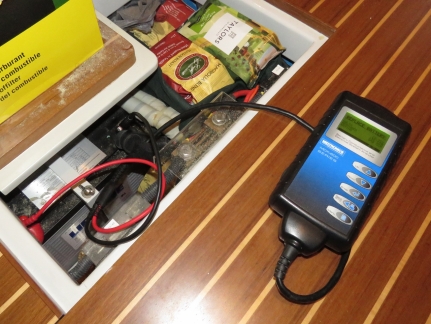 |
12V Battery
Position: 0 4.26, 51 30.40
The navigation system has a dedicated 12V battery that is only used for the few components that are unavailable in 24V variants. Almost all DC powered equipment on Dirona runs on 24V so the 12V bus is easy to ignore. But the 12V system powers some very important components, including NMEA2000. After the deep discharge the 12V system was just accidentally taken through, we tested the battery and it’s capacity has diminished to only 136 CCA, so it’s past time we replaced it. We have a battery on order, will add testing our 12V battery to our annual battery test, and will put voltage monitoring on the 12V system.
|
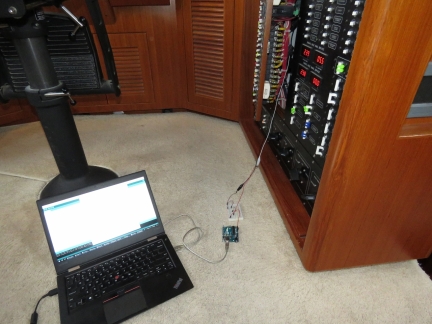 |
Voltage Monitoring
Position: 0 4.26, 51 30.40
Our accidental discharge of the 12V navigation system bus reminded us we need to monitor it just as we monitor our 24 volt DC system and the 120V and 240V AC systems on Dirona. Here James has a resistive voltage divider taking 0 to 16V down to 0 to 5V to be detected by an Arduino. It’s working but producing voltage levels that vary +/-0.5V around the actual voltage level so he’s changing the Arduino program to sample the voltage twice a second and to average the last 50 readings when producing a voltage level.
It’s now producing fairly stable voltage readings so he’ll next get the Arduino attached to one of the already-deployed Raspberry Pis so the data can be relayed back to the control system. In this case, it’s important that the 12V system monitoring and alarms not be NMEA2000 devices since the NMEA2000 system is fed by the same 12V bus. |
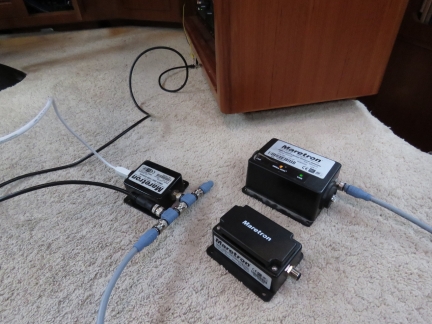 |
IPG100
Position: 0 4.26, 51 30.40
Once we got the NMEA2000 bus back up, we still weren’t getting data to our N2kView display. The Maretron IPG100 appeared to have not survived the deep discharge of the 12V system and, when the NMEA2000 bus voltage levels went low, the IPG100 failed. We have a spare, so last night we just changed the IPG100 so all control systems and reporting is quickly back to operational. The failed device is clearly operating but with firmware corruption so it should be possible to recover it.
Here James has the IPG100 on a stand-alone NMEA2000 network in an effort to recover the device. This often works but it appears that this IPG100 is not going to be recoverable so we’ll have to get another spare. We find the Maretron equipment relatively cost-effective and so we have a spare of everything. If any problems come up, having spares makes problem determination super-easy: try a new one and have the answer in seconds instead of after hours of investigation. Having spares makes the problems easy to find and quick to correct. |
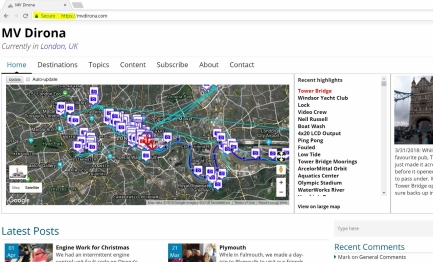 |
HTTP Secure
Position: 0 4.26, 51 30.40
We’ve just finished upgrading our site to HTTP Secure (HTTPS) and while we were at it upgraded to the new AWS Linux 2. The HTTP upgrade involved a lot of site-wide changes to remove references to http—let us know if you see any broken links or other issues.
|
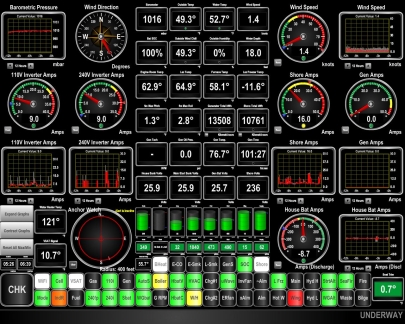 |
Wing Off Too Long
Position: 0 4.26, 51 30.40
Earlier today the automation system put on the wing engine indicator light (red at bottom right) since it’s been three weeks since the wing was last run. We like to run the engines at least every three weeks to keep them well oiled and condensation free.
|
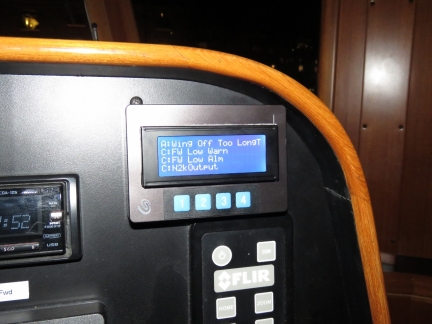 |
LCD
Position: 0 3.45, 51 30.32
We’re really liking our new LCD that shows the four most recent alarms and warnings from our automation systems. When the wing indicator light went red, a quick glance showed what the issue was: “Wing Off Too Long”
|
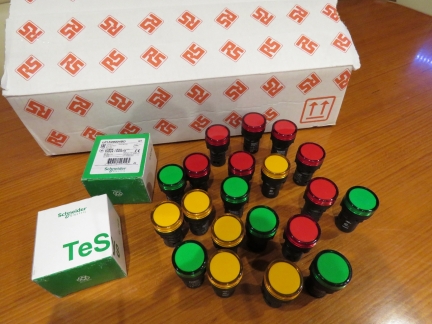 |
RS Components
Position: 0 4.26, 51 30.40
We got the electrical box and some other parts at City Electrical Factors but they didn’t have the Schneider 20A 240V contactors with 24VDC control, so we picked them up from RS Components. We’ve ordered from RS Components twice now this week and both times the order arrived the next day with everything we wanted. They seems to have a vast stock and work super-efficiently to get orders out. These 24V LED indicator lights are only £2.86 each.
|
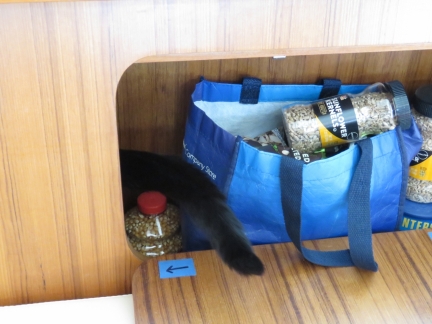 |
Spare Spitfire
Position: 0 4.26, 51 30.40
We found yet another “spare Spitfire” in the locker behind the salon settee.
|
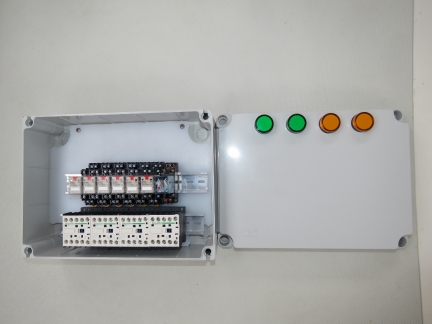 |
Twin Shore Power
Position: 0 4.26, 51 30.40
One of the things we really like about our more flexible power system is it allows us to run on shore power connections that deliver less than our peak power requirements. We easily can run on a 16A/240V connection for example with the house power draw peaking around 25A while we draw only 16A from shore. As long as our average draw is less than the shore power available, we keep up fine and never need to run the generator at dock.
Liverpool was the first place where we found running on a 16A service an inconvenience. When the temperatures drop down to the low 40F or into the 30s, our average power requirement rises and eventually will exceed the 16A available from shore at many marinas. When this happens the batteries begin a slow but steady discharge. The easy solutions are to heat a smaller part of the house, heat them less, or just switch over to the diesel heat. The latter solution of just using the diesel heating system works great, but is slightly more expensive than using shore power to heat. When it’s cold, we usually just switch over to diesel heat and continue to run well on 16A power when more isn’t available. Two issues have caused us to look for a shore related solution: 1) we’ve been told that some docks in Norway have only 8A service and there is no way we can run on 8A, and 2) we plan to spend 4 months next winter in Amsterdam and the marina we are looking at has only a 16A service. We like to be toasty so, over the course of 4 months, that will end up consuming a lot of fuel. So we’re investigating solutions that will allow us to use 2x 8A when only an 8A service is available or 2x 16A when it’s cold and we don’t want to run the diesel furnace at the dock. The obvious answer is to combine the two low-amperage connections since they are phase-aligned. But there many reasons why this is unsafe and not allowed by most, if not all, local electrical codes. A better solution, that is safe, is to split our charging system supply bus in two where one shore power connection feeds one 100A charger and then we add a second shore power connection to feed the second 100A charger. Each charger can consume around 13A allowing the boat to effectively run as though it had a single 32A connection. And, if at a dock with only an 8A service, the two chargers’ output can be adjusted downward through the user interface to only draw 8A so we can still have 16A for use on the boat. Using this approach we can run on almost any shore power configuration no matter how small. In this project, we will allow the second charger to be taken off the shore power bus and moved to shore power #2 and we are also centralizing some existing control system logic already installed on Dirona in the same control box. We’ll cover the details in a subsequent blog entry. |
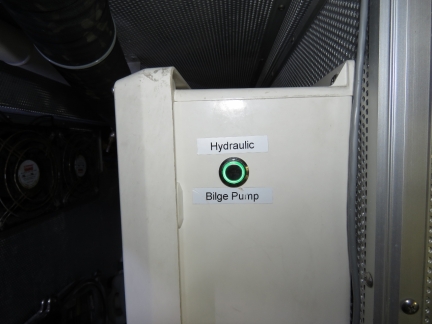 |
Bilge Pump Switch
Position: 0 4.26, 51 30.40
As part of the follow-up to dealing with our water ingress issue in the North Atlantic, we’d installed a switch in the engine room to control the hydraulic bilge pump. This worked well, but we’d found it was easy to accidentally bump the switch and turn the pump on. So today we replaced it with a flush-mounted switch that is as easy to operate, more robust, and much less likely to be accidentally bumped on.
|
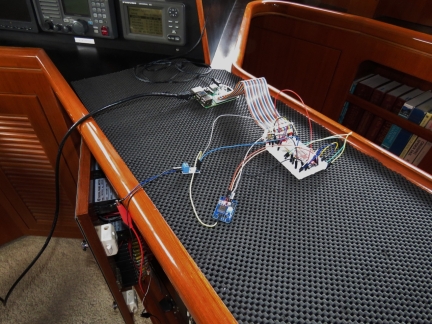 |
Voltage Sensing
Position: 0 4.26, 51 30.40
The 24V-to-12V converter that powers the 12V navigation system bus was inadvertently shut off a few days back and we didn’t notice as the backup battery on that bus discharged. It’s important that lead-acid batteries not be discharged below 50% and we have monitors and alarms on just about every possible problem on Dirona but somehow had missed this one.
Today James built a voltage sensor using a PCF8591 analog-to-digital converter. This A-to-D converter attaches to the Pi on the I2C (Inter-Integrated Circuit) bus that is also used by that Pi to control the 4×20 LCD display. I2C devices are easy to use, requiring only 4 wires (voltage, ground, and 2 signals), and all I2C devices can use the same 4 wires so it doesn’t consume any additional Pi GPIO pin resources. The PCF8591 detects voltage between 0 and 5V and converts it to a digital number between 0 and 255 that can be easily read by the Pi. We have a resistive voltage divider that takes a 0-25V range and produces a 0-5V range directly readable by the PCF8591. We now have a voltage sensor on the 12V navigation system power bus and set red indicator lights, send email, and sound alarms on low voltage levels. Using these electrical components allowed the problem to be solved for well under $10. Of course, that’s ignoring that his time might be worth something :-). He ended up going with this design over the Arduino design which worked equally well because this one a little simpler and more extensible. It also happens to cost less, although that really isn’t that much of a goal. |
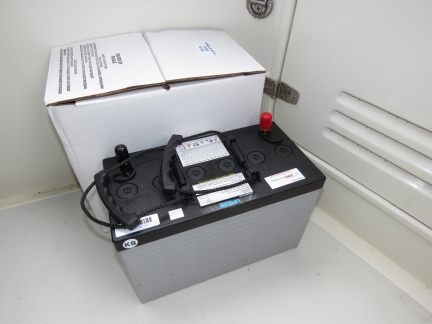 |
12V Battery
Position: 0 4.26, 51 30.40
Our replacement 12-volt battery arrived today. Nordhavn Europe ordered it for us—they were able to get us a good price and quick delivery to arrive before we leave early next week.
|
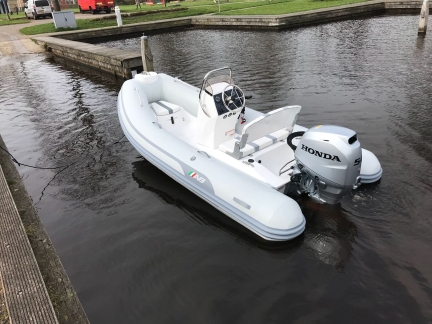 |
AB 12VST
Position: 0 4.26, 51 30.40
Our new AB 12VST tender has just arrived in at Boot Akkrum in Akkrum, Netherlands. We’ll be picking it up in Harlingen, Netherlands en our way to Norway.
Our current tender is 9 years old (1 year older than Dirona) and has 550 hours on it. We were hoping to get it to last 10 years and it got close but the full seam blowout in Scotland while underway convinced us the current boat is starting to show it’s age. We really want a safe and reliable tender when boating in secluded regions of Norway as planned for this summer. It’s a bit unusual to purchase a tender from the Netherlands when boating in Scotland on the knowledge that we will be passing through the Netherlands in a few months, but the boat looks great and we’re really looking forward to taking delivery. |
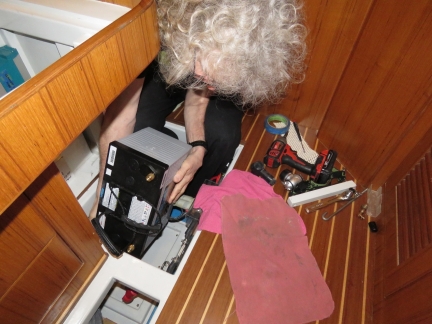 |
12V Battery
Position: 0 4.26, 51 30.40
We replaced the 12V battery today. Getting the old one out and the new one in was a bit tricky with some pipes in the way, but James managed to slide them in and out on end.
|
 |
Floor
Position: 0 4.26, 51 30.40
The battery could have been a lot more difficult to replace had it been more built in. Luckily the floor above it is designed to be removed.
|
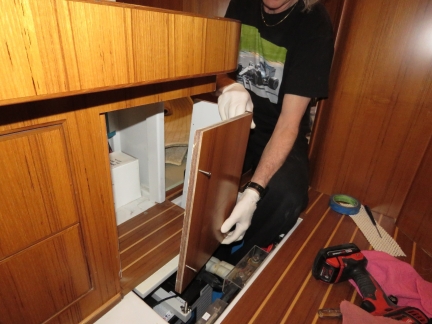 |
Corner
Position: 0 4.26, 51 30.40
The corner of the bed also is designed to be removed. Had this and the floor been permanent, replacing that 12V battery would have been a major job. Instead it took perhaps 20 minutes including cleanup.
This is one of the ways that Nordhavns really are different. You can’t tell from the outside, and you wouldn’t really notice in the first few months of ownership, but the boats are designed to allow efficient service. Here, seven screws can be undone and the entire corner of the bed above the battery can be removed. |

|
Click the travel log icon on the left to see these locations on a map, with the complete log of our cruise.
On the map page, clicking on a camera or text icon will display a picture and/or log entry for that location, and clicking on the smaller icons along the route will display latitude, longitude and other navigation data for that location. And a live map of our current route and most recent log entries always is available at mvdirona.com/maps. |

The coating is white, the thickness when done is around 1/64″ with 2 coats however one coat that covers would be sufficient. You can wash it, to remove it would take a wire brush on a 4″ grinder. You should not apply it to the plastic parts only the metal. If you practice some on a test piece you can get it looking like a coat of paint
Thanks Steve.
Obviously it’s not much of a problem since you’ve never noticed it before but, here is a product I use quite a bit that can deal with condensation on pipes like your HVAC strainer if you are interested.
http://vapcoproducts.com/no-sweat.html
Looks like another useful product. Thanks for the idea Steve. How thick is the film, what color, and is it washable or removable?